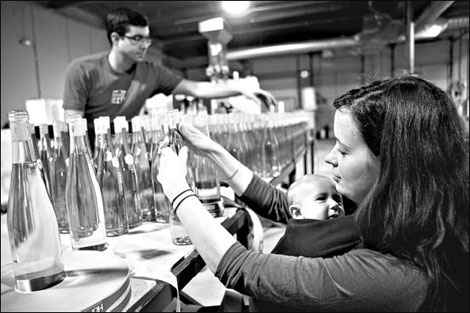Mead's renaissance: a brew so old it's new
Updated: 2012-03-04 07:49
By Michael Sanders (The New York Times)
|
|||||||||||
|
An explosion of brewing styles has made mead popular. Ben Alexander and his wife and son at their Maine mead company. [Craig Dilger for The New York Times] |
Mead, made from fermenting a solution of honey and water and once a staple of so many cultures, had faded into ignominy.
Now, mead's reputation is being restored. This may be partly due to the explosion in styles of mead as its makers move past the sweet, slightly caramelized, honey-forward traditional mead. Today, you can find meads dry-hopped and as flinty and sere as the bleakest unoaked Chablis; light summer quaffers with the freshness and subtle bubbles of a good prosecco; complex, multilayered dessert meads perfect with chocolate; even seasonal meads flavored with saffron, sage, fruits or juniper berries.
"Mead is a wine and a wine made with honey instead of grapes," said Vicky Rowe, a director of the annual Mazer Cup International Mead Competition. "People are realizing that's what it is and treating it as such."
Mead's flavors can be attributed to the honey that's used. Terroir is captured from the flowers whose pollen bees collect in a particular area at a particular time.
Ben Alexander is introducing three reserve meads to add to five other new styles he has been making at Maine Mead Works in Portland since 2008. "Honey and water," he said, "go in one end and move slowly through the system, the yeast converts the natural sugars to alcohol. It comes out on the other end at about 10 percent alcohol."
After the liquid ferments in steel tanks for a few months, the alcohol rises to about 12 percent before bottling. Some of the reserves age up to a year. "Our process helps produce a dry, light mead, which retains more of the subtle flavors of the honey," Mr. Alexander said.
While traditional meads can have more than 10 percent residual sugar, Mr. Alexander's come in under 2 percent. Combined with a rock-bottom acidity, the result in nose and palate can be remarkably like drinking dry white wine, with a delicate overlay of fruit and floral aromas.
At the Spints Alehouse in Portland, Oregon, the owner, Alyssa Gregg, uses Chaucer's Mead from Soquel, California, in a variety of seasonal cocktails. "Mead has an earthiness to it," she said. "It can add a mild sweetness and dryness at the same time." She'll use it in a drink with mezcal, where the mead, she said, "tames the alcohol and answers the heat."
New York State's largest meadmaker is Earle Estates Meadery. It makes about 10,000 cases a year. The owner, John Earle, attributes his business's growth to the use of ultrafiltration.
"The machine strips out the protein that the bees put into honey in the process of making it," Mr. Earle said. "That protein has been tied to the harshness of mead, so, take out the protein, and it's smoother."
At the Dogfish Head brewery in Milton, Delaware, Midas Touch, the most popular honey-based fermented beverage in the United States, is made with barley, honey, white muscat grapes and saffron. Beer? Wine? Mead? "We have no interest in marketing it as anything other than MidasTouch, a beer-mead-wine, take your pick," said Sam Calagione, the brewery's founder. Midas Touch is based on the ingredients found in 2,700-year-old drinking vessels from the tomb of King Midas.
As David Myers, owner of Redstone Meadery in Boulder, Colorado, likes to joke, "Mead is a beverage whose popularity comes around like clockwork - every two or three thousand years."
The New York Times
Today's Top News
Rescuers race against time for quake victims
Telecom workers restore links
Coal mine blast kills 18 in Jilin
Intl scholarship puts China on the map
More bird flu patients discharged
Gold loses sheen, but still a safe bet
US 'turns blind eye to human rights'
Telecom workers restore links
Hot Topics
Lunar probe , China growth forecasts, Emission rules get tougher, China seen through 'colored lens', International board,
Editor's Picks

|

|

|

|

|

|






